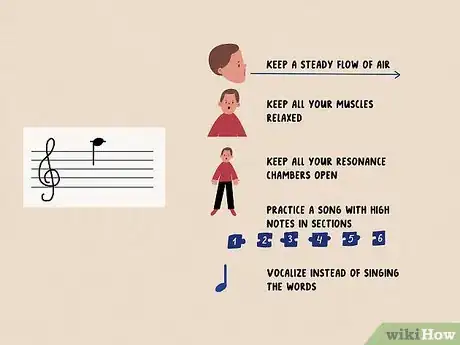This article was co-authored by Amy Chapman, MA. Amy Chapman MA, CCC-SLP is a vocal therapist and singing voice specialist. Amy is a licensed and board certified speech & language pathologist who has dedicated her career to helping professionals improve and optimize their voice. Amy has lectured on voice optimization, speech, vocal health, and voice rehabilitation at universities across California, including UCLA, USC, Chapman University, Cal Poly Pomona, CSUF, CSULA. Amy is trained in Lee Silverman Voice Therapy, Estill, LMRVT, and is a part of the American Speech and Hearing Association.
There are 10 references cited in this article, which can be found at the bottom of the page.
wikiHow marks an article as reader-approved once it receives enough positive feedback. This article received 19 testimonials and 97% of readers who voted found it helpful, earning it our reader-approved status.
This article has been viewed 303,800 times.
Just like you need to warm up your body before an intense workout, you always want to warm up your voice before singing. Warming up your singing voice isn’t hard, and there are lots of different exercises you can try. Not only will these exercises warm up your voice, they’ll also warm up your lungs, lips, and tongue so you feel relaxed and ready to sing your heart out.
Steps
Warming up Your Body
-
1Open up your throat. One of the first and easiest steps to warm up your body and your throat before you sing is to open your throat and diaphragm by yawning.[1] Gently force yourself to yawn by opening your mouth as though you were about to yawn. As you do this, think about yawning, or watch a video of someone yawning to initiate your own yawn.
- Repeat this two or three times to fully open your throat and diaphragm.
-
2Engage your core. Using your abdominal muscles and singing from the right place in your body is very important when you sing.[2] To engage the muscles you should be using, very gently force yourself to let out a small cough. Pay attention to which muscles are involved in that action, as these are the muscles you should be using when you sing.[3]
- The muscles of the core include the psoas, the pelvic floor, and the diaphragm, among others. Engaging these muscles during singing will help you achieve your fullest voice.
Advertisement -
3Relax your neck and shoulders. You want your entire body to be relaxed when you sing, because you don’t want to strain your body or your muscles when you sing high notes. To relax your upper body, simply shrug your shoulders, hold them in a hunched position for five seconds, then relax them. Repeat four or five times.[4]
- Your voice should always come from your diaphragm, but sometimes people will try to push from a higher place on their body instead of the belly when reaching for high notes.
- To prevent this, continue relaxing your neck and shoulders throughout your warm up, especially when going for high notes.
-
4Do a breathing exercise. Because the breath is the mechanism that creates your voice, it’s also important to do a few breathing exercises before singing as well. Two exercises you can do are:[5]
- As you keep your shoulders and chest relaxed, inhale deeply into your diaphragm, so that your stomach rises slightly. Then exhale slowly from this same place, so that your belly flattens out again. Continue breathing this way for two minutes.
- Inhale like before, but when you exhale, practice allowing the breath to escape slowly as you make a hissing sound with your mouth. Repeat for one minute.
-
5Release tension in your jaw. Tension in your jaw and mouth can also affect your singing, so relax this area before singing. To release this tension:
- Place your palms on your cheeks and allow your jaw to open to a natural position.
- Slowly and gently move your hands around to massage the jaw and facial muscles for one to two minutes.[6]
Practicing Vocal Warm-up Exercises
-
1Hum. Start by making a basic “hmmm” noise in your throat in your lower range as you exhale a breath. Repeat this five to 10 times, then repeat the same sound with your mouth open for five to 10 breaths. With your mouth open, you should make an “ahhhh” noise.[7]
- Humming is a great way to warm up and relax the muscles of your throat, face, neck, and shoulders, and it can also help you control your breathing.[8]
-
2Hum do-re-mi. Once your voice is warmed up with basic humming, begin to warm up for pitch changes by humming do-re-mi up the scale and then back down. Start at the lower end of your pitch range, and when you complete one sweep up and down the scale, go to a higher key and repeat.
- Repeat this for four or five ascending keys, then work your way back down those same keys.[9]
-
3Do some lip trills. Lip trills, also called lip buzzing or bubbling, are an exercise that vibrates and warms up your lips as well as your voice.[10] To create the lip trill, you close your lips loosely, pout them slightly, and blow air through them (think of making the sound of a motor or raspberry). Do this for two exhales, then start slowly shaking your head from side to side as you do three or four more lip trills.[11]
- Repeat the lip trilling and head shaking, and as you do this make a “b” sound with your mouth as you do vocal sweeps starting with a high note and going low, and then coming back up.
-
4Practice the siren song. Make an “ng” sound in your nose as though you were just saying the final part of the word “sung.” Continue to make this noise as you do three to five pitch sweeps. Every time you go back up and down again, push your voice into a slightly higher and lower pitch range.[12]
- This exercise helps you warm up the voice gradually, prevents over-exertion of the voice, and helps singers transition between their head and chest voices,[13] which refers to the different places air resonates in the body when creating different sounds and pitches.
-
5Practice tongue twisters in different pitches. Tongue twisters are great for articulation practice, and if you say them in different pitches and at different volumes, they can be a great way to warm up before singing. Some good tongue twisters to try out are:[14]
- Sally sells sea shells by the sea shore
- Teaching ghosts to sing
- Peter Piper picked a peck of pickled peppers
- Unique New York
- The tip of the tongue, the lips, the teeth
- Really rural
- The big, black-backed bumblebee
- Red letter, yellow letter
Practicing Advanced Rehearsal Techniques
-
1Hold a sustained note. Sometimes songs require a singer to hold a note for an extended period, and if you aren't prepared for this or don’t have the right technique, you may not be able to hold the note for the full length. To practice holding a note:[15]
- Expand your ribs, tuck in your lower belly, and relax your shoulders and neck.
- Inhale slowly as you open your throat, arms, and chest, as though you were just surprised by something. Hold this openness while staying relaxed. This is the same technique you will use to hold a note.
- Now, choose a note in the middle of your range, repeat the above steps, but this time sing that note and hold it for as long as you can, keeping your throat open and relaxed as you sustain the note.
-
2Work on hitting high notes. If you’re going to be singing a song that requires you to hit some high notes, there are ways you can practice for this. The problem with high notes is that you can damage your vocal chords if you strain too hard to hit the notes. To reach high notes without causing damage, you need to:
- Practice keeping a steady flow of air as you sing.
- Keep all your muscles relaxed.
- Keep all your resonance chambers (the throat, mouth, nose, chest, etc.) open as you sing.
- Pick a song with high notes and practice it in sections until you become comfortable with each section.
- Practice the song once through without singing the words: instead, vocalize a single sound to go through all the pitches. When you're comfortable with that, sing the song, words and all, through entirely.
-
3Reach for low notes. A song with low notes can also be difficult to master because with low notes, you can easily lose control of the sound, because your vocal chords relax as the pitch descends.[16]
- To maintain control of your lower notes, it’s important to keep your throat relaxed and maintain resonance in your face.
- If you stop feeling the resonance in your face as you reach for lower notes, shake your head from side to side to open your throat and try again.
- Don’t worry if your volume drops with the lower notes, because lower notes cannot be sung at a loud volume. Instead, focus on maintaining the tone and clarity of the note, rather than the volume of your voice.
Expert Q&A
-
QuestionWhat helps your voice before singing?
 Amy Chapman, MAAmy Chapman MA, CCC-SLP is a vocal therapist and singing voice specialist. Amy is a licensed and board certified speech & language pathologist who has dedicated her career to helping professionals improve and optimize their voice. Amy has lectured on voice optimization, speech, vocal health, and voice rehabilitation at universities across California, including UCLA, USC, Chapman University, Cal Poly Pomona, CSUF, CSULA. Amy is trained in Lee Silverman Voice Therapy, Estill, LMRVT, and is a part of the American Speech and Hearing Association.
Amy Chapman, MAAmy Chapman MA, CCC-SLP is a vocal therapist and singing voice specialist. Amy is a licensed and board certified speech & language pathologist who has dedicated her career to helping professionals improve and optimize their voice. Amy has lectured on voice optimization, speech, vocal health, and voice rehabilitation at universities across California, including UCLA, USC, Chapman University, Cal Poly Pomona, CSUF, CSULA. Amy is trained in Lee Silverman Voice Therapy, Estill, LMRVT, and is a part of the American Speech and Hearing Association.
Singing Coach You can open up your throat with some light physical activity. Try doing some quick exercises, like jumping jacks or a short walk or jog, take a short break, and then do your vocal warm-up.
You can open up your throat with some light physical activity. Try doing some quick exercises, like jumping jacks or a short walk or jog, take a short break, and then do your vocal warm-up. -
QuestionIs it best to get singing lessons?
 Community AnswerIf you desire to sing, then absolutely. Singing is a wonderful talent for many people to have, and it helps us exercise our muscles. If you get good at it, you will begin to have opportunities to perform in front of others.
Community AnswerIf you desire to sing, then absolutely. Singing is a wonderful talent for many people to have, and it helps us exercise our muscles. If you get good at it, you will begin to have opportunities to perform in front of others. -
QuestionWhy is my voice croaky all the time?
 Community AnswerFor singers, hoarseness is most often caused by using your voice too much for too long without a proper break, straining your vocal chords, not warming up properly, and using improper singing techniques. You can prevent this by giving yourself a rest when you're practicing and using the right techniques.
Community AnswerFor singers, hoarseness is most often caused by using your voice too much for too long without a proper break, straining your vocal chords, not warming up properly, and using improper singing techniques. You can prevent this by giving yourself a rest when you're practicing and using the right techniques.
References
- ↑ https://www.youtube.com/watch?v=Q5hS7eukUbQ
- ↑ Amy Chapman, MA. Singing Coach. Expert Interview. 18 October 2019.
- ↑ https://www.youtube.com/watch?v=Q5hS7eukUbQ
- ↑ https://www.youtube.com/watch?v=Q5hS7eukUbQ
- ↑ http://www.entnet.org/content/vocal-warmup-put-your-best-voice-forward
- ↑ http://www.nyee.edu/patient-care/otolaryngology/voice-swallowing/therapy/vocal-warm-ups
- ↑ Amy Chapman, MA. Singing Coach. Expert Interview. 18 October 2019.
- ↑ http://thehealthylivinglounge.com/2009/08/06/12-instant-benefits-of-humming-daily/
- ↑ https://www.youtube.com/watch?v=nB_HuCMnnYk
- ↑ Amy Chapman, MA. Singing Coach. Expert Interview. 18 October 2019.
- ↑ https://www.youtube.com/watch?v=Q5hS7eukUbQ
- ↑ http://thesingingvoice.com/tips/vocal-warm-ups
- ↑ http://learn.singorama.com/how-to-sing/vocal-exercises/
- ↑ http://www.nyee.edu/patient-care/otolaryngology/voice-swallowing/therapy/vocal-warm-ups
- ↑ https://www.youtube.com/watch?v=Ni-gyVyTSks
- ↑ http://susananders.com/article-8-mastering-low-notes
About This Article
To warm up your singing voice, start by yawning a few times to open up your throat and diaphragm. Then, make a “hmmm” noise in your throat as you exhale 10 times, followed by an "ahhh" sound as you exhale another 10 times to relax the muscles in your throat and face. Next, try humming do-re-mi at the lower end of your pitch range, then repeat the scale at a higher range. You can also try saying some tongue twisters, like “Sally sells sea shells by the sea shore” or “Unique New York,” to practice articulating clearly. For more tips, including how to prepare to hit high notes in a song, read on!










































































